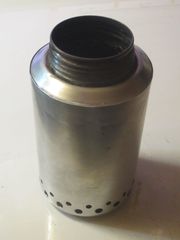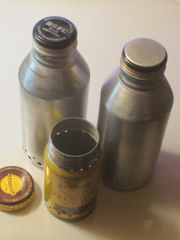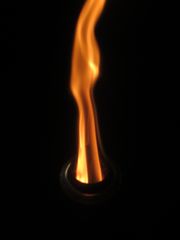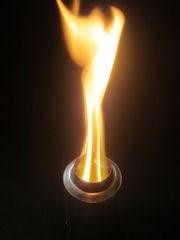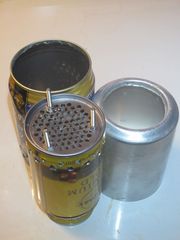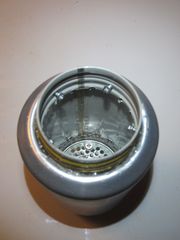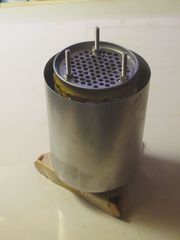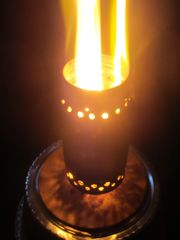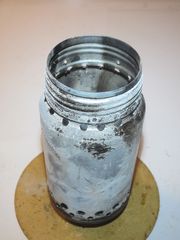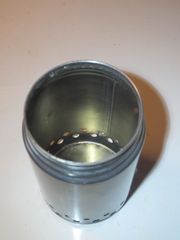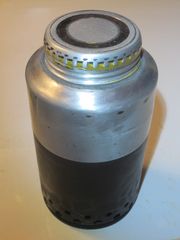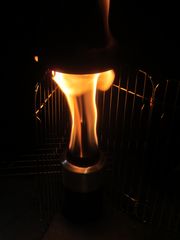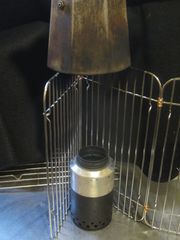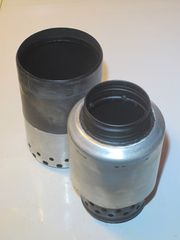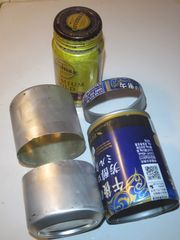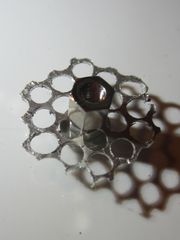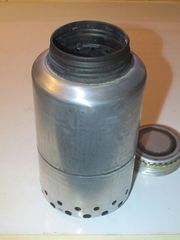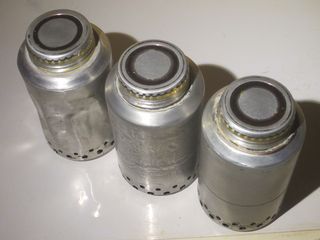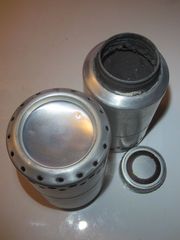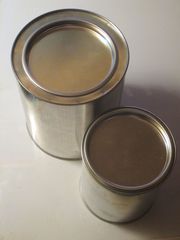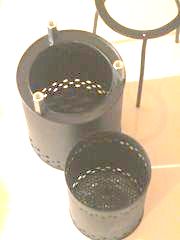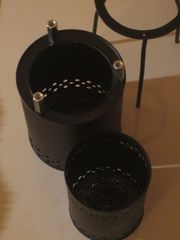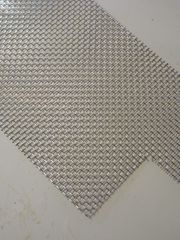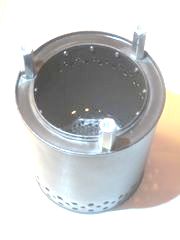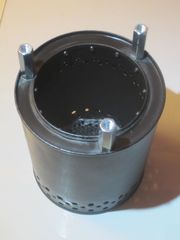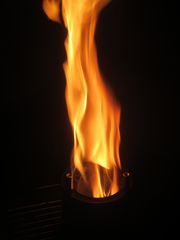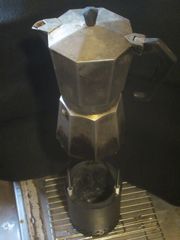Use a steel can for the lower part of the Outer Chamber. The other cans used are the same as in the chapter 1 prototype.
However, 350ml steel cans are no longer sold, although a couple of years ago, there were several kinds. The steel can in the image on the right is 280ml in size, and it is about 20mm short in height, partly because the top is constricted.
I'd like to use this somehow to achieve the same functionality as the prototype.
When using steel cans, I would like to consider rust prevention, especially for the Inner Chamber. I also want to systematically treat the joint between the Inner Chamber and the top of the Outer Chamber.
Cut out the top of the steel can with a can opener. Put an aluminum can on top of it to make an Outer Chamber.
The top aluminum can is basically the same as the prototype, but cut out a longer piece to cover the steel can.
The rest is the same as the prototype.
The joint between the Inner Chamber and the top of the Outer Chamber should be highly precise. This is the same as the prototype.
Fix it with some kind of adhesive in case you want to remove it later.
Then, drill a hole in the joint between the inner and outer chambers. Since it will be fixed with screws, drill a hole one size smaller than the screws to be used, insert the screws shallowly, and fasten them temporarily to check the accuracy of the joint.
I used epoxy, which is not heat resistant, as the adhesive. It can be fixed strongly, but can be easily removed by dipping it in boiling water.
Anti-rust
Melt the inner coating and the outer coating with fire.
First, the Inner Chamber, which also serves as a chimney effect combustion test.
The inner coating and the outer paint were burned to white ash.
I polished this with a sponge sander and cleaned it with anhydrous methanol, revealing a dull, shiny steel crust.
This is beautiful in its own way, but if used as is, it will certainly rust.
Too bad I can't find transparent heat-resistant paint.
The lower part of the Outer Chamber, the steel can, is also cleaned and degreased by burning the inner coating and outer paint with fire.
Heat resistant coating on these two steel cans.
I used a paint that can withstand up to 650 degrees Celsius, which should be enough for the Outer Chamber, but I won't know if the Inner Chamber can withstand the paint until I try it.
The flame temperature is supposed to be 700-800 degrees, so it might not work. Even the temperature of the charcoal fire will be about 650 degrees.
Using it is equivalent to hardening. It is done after the coating has sufficiently hardened.
The above is more durable than the prototype.
Combine. Contrary to the prototype, the top of the Outer Chamber will be outside the bottom.
The top and bottom have the same outer diameter. It was impossible to stack and push them together over several centimeters, so I set the height of the aluminum that would be the top to 40 mm.
I tried to expand the aluminum at the top, but it was too tough to do so. Maybe, though, if I turned on the fire, I could have pushed it in.
The joint of the Inner Chamber is fixed with screws, but since a small gap is created, it is filled with heat-resistant putty.
This heat-resistant putty should be applied as thinly as possible. In order to do this, it is important to have a high degree of precision in the aluminum joint area. By doing so, the putty-only areas will be thinner and smaller, and the brittleness of those areas can be avoided.
Then there's the hardening of the heat resistant coating. You can use this.
I made a pedestal from what I had and made 500 ml of espresso.
The only fuel is wooden disposable chopsticks.
I threw in 17 pairs of disposable chopsticks and it took me 15 minutes.
With a gas stove, it takes 7 to 8 minutes on medium heat. 15 minutes is more than practical, but from the looks of it, I thought it would have more heat. This is no different than a high efficiency alcohol stove.
Surprisingly, the firepower of the alcohol stove is stronger than the appearance of the flame.
I was able to make 500ml of espresso with 17 pairs of wooden chopsticks, which may be highly efficient. This could only be achieved by secondary combustion. If you can collect pine cones and twigs at the campsite, you will have no shortage of fuel.
As for the fire power, this size, very small for a wood gas stove, probably means that there is a limit. The apparent flame is quite powerful, though.
The burning pace, which can only throw in a little over one pair of disposable chopsticks per minute, is probably the immediate result of the weak thermal power.
postscript
The time taken to make the espresso was reduced by adding fuel in such a way as to maintain a strong heat rather than waiting for it to weaken.
By using 22 pairs of chopsticks in 11 minutes, I was able to make 500ml of espresso.
That's one chopstick every 30 seconds, closed to double the pace of the first experiment. It took 30% more fuel though.
Furthermore, in the next experiment, I was able to make 500ml of espresso by throwing in 18 pairs of disposable chopsticks in 10 minutes.
Although it was still cold season, the temperature had risen by about 4 degrees compared to the previous experiment. And the water temperature might be different.
The time and fuel might be more reduced to use it in summer.
The Inner Chamber is the same as in the previous chapter, and the aluminum can that holds the Inner Chamber in place is covered from the top as in the previous chapter.
For the Outer Chamber, use four cans, steel cans on the inside and aluminum cans on the outside.
Cut off the thinner part of the steel can, and cut another can to fill the missing length. Cut out the bottom with a can opener to make a cylinder with both sides removed.
Cover the bottom with an aluminum can and open the Ventholes with the aluminum and steel cans overlapping
This is done to eliminate weak areas of aluminum cans only, and to cover the heat-resistant coating of steel cans with aluminum cans without exposing it as much as possible, so that the cans can be handled roughly.
Parts added for this project. A small perforated metal bolt is attached to the center of the bottom of the Inner Chamber to create a partial double-bottomed structure.
The one in the image was too small, so a larger one was installed. This part is easy to install and remove even after completion, so it can be changed as an optional part.
This is a standard practice in wood gas stoves and allows for minimal airflow even if ash builds up at the bottom due to over-fueling or poor quality fuel.
The ends have ventholes on the sides and airflow is rarely obstructed. Double-bottomed only in the center to ensure airflow from the center of the bottom and to allow airflow to the sides even if fuel is blocked on it.
Push in and complete.
Can be inserted into bicycle holders without hesitation.
This is enough for day campers to make simple food and coffee.
Wish to have a base for pots and pans that can be folded and compacted.
Of course, I'd like to get another two sizes larger.
An additional part.The aluminum parts installed at the bottom of the Inner Chamber began to melt and deform due to the high heat. I plan to replace it with stainless steel.
It may be difficult to see in the above images, but the gap between the top and bottom aluminum cans was about 1.5 mm immediately after completion, but it became less than 0.5 mm while being used. The aluminum may have been stretched by the heat.
It does not appear to extend further with repeated use. Coincidentally, but miraculously, it fits perfectly.
The second stove was also dismantled and rebuilt.
The first prototype had an aluminum-only Outer Chamber that was wavy and deformed. However, functionally, it remains normal.
I put it under the ventilation fan and use it as a shredder.
Note the underside of the bottom of the chamber, where the three bolts that form the legs of the Inner Chamber are pressed against each other, creating small protrusions. This holds the Inner Chamber in place at the top and bottom, making it more resistant to vibration during transportation.

